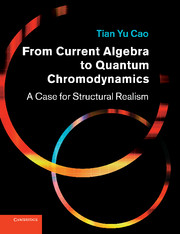Book contents
- Frontmatter
- Contents
- Preface
- 1 Introduction
- 2 The rise of current algebra
- 3 Sum rules
- 4 Saturation and closure
- 5 Scaling
- 6 Theorizations of scaling
- 7 The advent of QCD
- 8 Early justifications and explorations
- 9 Structural realism and the construction of QCD
- 10 Structural realism and the construction of the CA–QCD narrative
- References
- Author index
- Subject index
8 - Early justifications and explorations
Published online by Cambridge University Press: 06 December 2010
- Frontmatter
- Contents
- Preface
- 1 Introduction
- 2 The rise of current algebra
- 3 Sum rules
- 4 Saturation and closure
- 5 Scaling
- 6 Theorizations of scaling
- 7 The advent of QCD
- 8 Early justifications and explorations
- 9 Structural realism and the construction of QCD
- 10 Structural realism and the construction of the CA–QCD narrative
- References
- Author index
- Subject index
Summary
In spite of the simple appearance of its Lagrangian, QCD is an extremely complicated and rich theory. As a theory of strong interaction, it is subject to various constraints posed by observations. Most important among them are scaling and confinement, which appear to have conflicting implications for the nature and characteristics of QCD. It also has many observational implications, such as the logarithmic violations of scaling, the spectrum of charmonium, and the two-jet and three-jet structure in the electron–positron annihilations. The successes in satisfying these constraints and in explaining and predicting observational events in the early to mid 1970s immediately after the proposal of QCD had provided QCD with much needed experimental justifications and consolidated its status as an acceptable theory in the particle physics community.
As a non-abelian gauge theory, QCD is also subject to some conceptual constraints posed by its symmetry structure, such as the U(1) anomaly (see Sections 8.2 and 8.5 below). The solution of the U(1) anomaly relied on the further explorations of the theoretical structure of QCD, which revealed its richness and great potential for theorizing the complexity of the sub-hadronic world, such as the existence of instantons and the related theta vacuum state. The fruitful explorations in this direction had shown that QCD, in Lakatos's terminology, was a progressive research program, which keeps opening new territory for explorations, and thus was conceived by the majority of the community as worth pursuing.
- Type
- Chapter
- Information
- From Current Algebra to Quantum ChromodynamicsA Case for Structural Realism, pp. 160 - 201Publisher: Cambridge University PressPrint publication year: 2010



